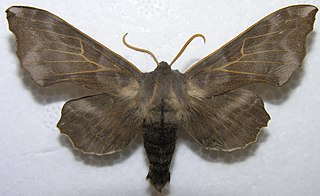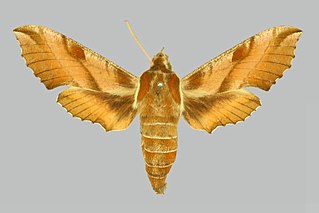
Tethea ocularis, the figure of eighty, is a moth of the family Drepanidae. It is found throughout continental Europe and has a scattered distribution in England and Wales, although it is absent from Scotland and Ireland.
The Amur lemming is a species of lemmings found near the Amur River in Siberia.

Vitis amurensis, the Amur grape, is a species of grape native to the Asian continent. Its name comes from the Amur Valley in Russia and China.
Rana amurensis is a species of true frog found in northern Asia. It ranges across western Siberia, as well as northeastern China, northeastern Mongolia, and on the northern Korean Peninsula and on Sakhalin. Rana coreana was previously included in this species as a subspecies.

Laothoe amurensis, the aspen hawk-moth, is a moth of the family Sphingidae. It is found in the northern part of the Palearctic ecozone. It flies in May and can be found only in far-eastern Europe, including parts of Poland, Finland, Ukraine and Belarus. It exists also in Asia as few another subspecies. In spite of being very rare, it is not protected, e.g. in Poland. There are known few places where obtaining this moth by attracting to light is possible.
Rhyparioides is a genus of tiger moths in the family Erebidae.

Deilephila askoldensis is a moth of the family Sphingidae. It is found in southeastern Russia, northeastern China, the Korean Peninsula, and northern Japan. D. askoldensis has a wingspan of 51–59 mm. Larvae feed on Vitis amurensis in Russia and Epilobium species in Japan.

Brahmaea certhia, the Sino-Korean owl moth, is a moth from the family Brahmaeidae, the Brahmin moths. It is found in the Korean Peninsula and China.

Epinotia tenerana, the nut bud moth or alder tortricid, is a moth of the Tortricidae family.
Phyllocnistis vitella is a moth of the family Gracillariidae, known from Russia. The hostplant for the species is Vitis amurensis.
Acrocercops amurensis is a moth of the family Gracillariidae, known from Russia and China. The hostplant for the species is Quercus mongolica.

The Micrarctiina are a subtribe of woolly bear moths in the family Erebidae. Many of these moths are of small or medium size and have bright-colored hindwings.

The Butterbur is a species of moth in the Noctuidae family. It is found from most of Europe, east to Siberia and Japan.
Eupithecia amurensis is a moth in the family Geometridae. It is found in Russia.
Asthena amurensis is a moth in the family Geometridae. It is found in the Russian Far East, Korea and Japan.
Phragmatobia amurensis is a moth in the family Erebidae. It was described by Seitz in 1910. It is found in the Russian Far East, China, Korea and Japan.

Rhyparioides metelkana is a moth in the family Erebidae. It was described by Lederer in 1861. It is found in southern and central Europe, Russia, eastern Asia and Japan.
Rhyparioides nebulosa is a moth in the family Erebidae. It was described by Arthur Gardiner Butler in 1877. It is found in the Russian Far East, China, Japan and possibly Korea.
Rhyparioides subvaria is a moth in the family Erebidae. It was described by Francis Walker in 1855. It is found in China, Korea and Japan (Tsushima).
Zeiraphera corpulentana is a species of moth of the family Tortricidae. It is found in China, Korea, Japan and Russia.










